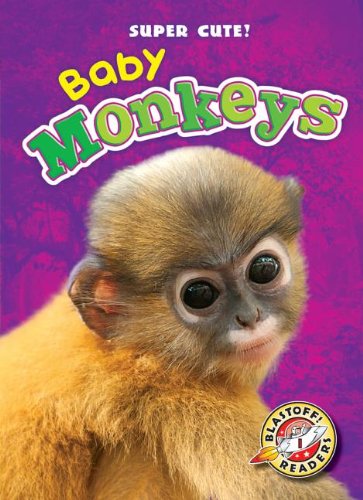-
Baby Monkeys
Kate Riggs
Hardcover (Creative Education/Creative Paperbacks, Jan. 15, 2019)Celebrating the life, growth, and development of six baby animals, Starting Out narrates the tale of growing up in the wild. This new series employs simple language and a unique first-person perspective to introduce foundational biological concepts as it follows the adorable animal through the start of its young life. The straightforward text and large photos of the animal in its natural environment will both entertain and enlighten as readers learn how the animal's physical features, diet, habitat, and familial relationships play a role in its growth and development. A baby monkey narrates the story of its life, describing how physical features, diet, habitat, and familial relationships play a role in its growth and development. G
G
-
Baby Monkeys
Kari Schuetz
Library Binding (Blastoff Reader, Aug. 1, 2013)"Developed by literacy experts for students in kindergarten through grade three, this book introduces baby monkeys to young readers through leveled text and related photos"-- H
H
-
Monkeys
D. Dennard
School & Library Binding (San Val, Jan. 15, 2003)None
-
Baby Monkeys
Kate Riggs
Paperback (Creative Paperbacks, March 12, 2019)Celebrating the life, growth, and development of six baby animals, Starting Out narrates the tale of growing up in the wild. This new series employs simple language and a unique first-person perspective to introduce foundational biological concepts as it follows the adorable animal through the start of its young life. The straightforward text and large photos of the animal in its natural environment will both entertain and enlighten as readers learn how the animal's physical features, diet, habitat, and familial relationships play a role in its growth and development. A baby monkey narrates the story of its life, describing how physical features, diet, habitat, and familial relationships play a role in its growth and development. G
G
-
Monkeys
L.E. Arning
eBook (University Standard Media, June 21, 2020)From the author: “This series has been one of the great adventures of my life; researching these creatures and obtaining these photos has transformed how I view humankind and the beautiful world around us.” – L.E. Arning | Copyright University Standard Media After years of effort, L.E. Arning has delivered a captivating series that is designed for childhood education but can be enjoyed by everyone; children ages 6 to 8 tend to become very engaged with this series but it can be used with early readers as well. The “Nature & Science” series explains complex facts about animals and critters in easy-to-understand language; these books are simple to read and easy to retain for kids of all ages. L.E. Arning is an experienced author in this genre; this series follows the best-selling “All About” books for kids series, but with double the number of new and exciting creatures and double the number of facts and photos in each book.
-
Monkeys
Breanne Satori
eBookNone
-
Monkeys
Cari Meister
language (Jump! Library, Feb. 22, 2019)In Monkeys, beginning readers will learn how monkeys survive in the wild. Vibrant, full-color photos and carefully leveled text will engage early readers as they discover the many ways a monkey uses its hands. A labeled diagram helps readers identify a monkey's body parts, while a picture glossary reinforces new vocabulary. Children can learn more about monkeys online using our safe search engine that provides relevant, age-appropriate websites. Monkeys also features reading tips for teachers and parents, a table of contents, and an index. Monkeys is part of Jump!’s My First Animal Library series.
-
Monkeys
Valerie Bodden
Paperback (Creative Paperbacks, Feb. 18, 2020)From winged bats to furry wolves, and from leaping dolphins to stalking lions, the world of animals is wonderfully diverse. This popular series travels the planet to study these and other fascinating mammals, birds, reptiles, fish, and invertebrates. Beautiful photos are paired with STEM-appropriate text to examine the featured creature's appearance, habitat, behaviors, and life cycle. Each reissued title also presents a folk story that people have used to help explain the animal's appearance or behavior. This revised edition surveys key aspects of monkeys, describing the playful primates' appearance, behaviors, and habitats. A folk tale explains why these creatures look almost like people. F
F



